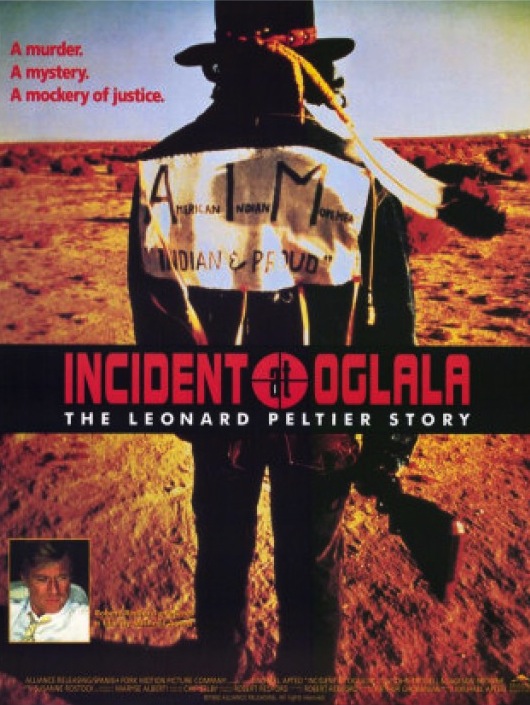Monday, August 17, 1992.
INCIDENT AT OGLALA: The Leonard Peltier Story. No writer credited. Music by Jackson Brown, Bill Cavanaugh, Craig Doerge and Ari Frankel. Directed by Michael Apted. Running time: 93 minutes. Mature entertainment with the B.C. Classifier's warning: occasional coarse language.
HE PROMISED US THE story behind the story.
Four months ago [April 1992], his fictional feature Thunderheart offered us action with a social conscience. In it, director Michael Apted told a story of murder and intrigue on a South Dakota Indian reservation, a drama inspired by mid-1970s events.
At the same time, Apted was involved with activist-actor Robert Redford in producing a documentary examining those very events.
Thunderheart addressed the issues with the clarity and resonance of a well-crafted political thriller. Since its April opening, I've been waiting for Apted to drop his other shoe.
Instead, he drops the ball. Incident at Oglala (subtitled The Leonard Peltier Story), his film examining a 1975 shootout on South Dakota's Pine Ridge Reservation and its legal aftermath, is a rant rather than a revelation.
In it, Apted argues that, in the 1977 trial of accused murderer Leonard Peltier, the U.S. government failed to make its case and, further, that that conviction was a miscarriage of justice.
But Apted fails to make his case. Despite the best of intentions, his picture raises more questions than it answers.
In the "incident," two FBI agents pursuing a man "wanted for the theft of a pair of cowboy boots" were shot and killed.
Two years later, on Monday, April 18, 1977, American Indian Movement (AIM) member Peltier was found guilty of two counts of first-degree murder. Says Redford: "There still exists significant confusion about the facts in his case."
That's putting it mildly.
Apted, who demonstrated his talent for soft-core documentary in the 35 Up series, seems to believe that talking heads, newsreel footage and some dramatic reconstructions tell us all we really need to know.
With next to no historical detail, we are offered the U.S. government, its Bureau of Indian Affairs (BIA), the FBI and the reservation's own tribal council leader as bad guys. They are out to destroy AIM and its members.
Some facts noted in passing:
* The reservation had the highest murder rate per capita in the U.S. While the FBI was engaged in "one of the biggest manhunts in its history," at least 60 murders of "traditionals" and AIM supporters remained unsolved.
* Also during this period, more than 500 criminal charges were brought against AIM members. "Ninety per cent of anti-AIM cases were dismissed or resulted in acquittal."
Such facts are provided more to stimulate outrage than to enhance understanding. What executive producer Redford's narration fails to explain is the enmity between "full bloods" and "mixed bloods," the statutory responsibilities of the BIA, the presence of the FBI on the reserve or the reason for the U.S. justice department's apparent vendetta against AIM.
Apted suggests that prosecutors faked affidavits, presented perjured testimony and manufactured evidence to convict Peltier. What he fails to do is establish a convincing motive.
Pure evil is not the answer.
But, since the devil didn't make them do it, who did? And why?
Ideals (Apted's) and sincerity (Redford's) are not enough. Nor is a factually incomplete documentary that preaches to the converted.
The above is a restored version of a Province review by Michael Walsh originally published in 1992. For additional information on this archived material, please visit my FAQ.
Afterword: Like The X-Files special agent Fox Mulder, I want to believe. What I also want is that a documentary filmmaker make his case beyond a reasonable doubt. When Incident at Oglala was released, its promotional materials reminded us that "in 1988, The Thin Blue Line helped free a man. Now as a man's life hangs in the balance, comes a true portrait of American injustice that is even more shocking." Documentarist Errol Morris's 1988 feature made its case, and it did indeed bring about the release of the wrongfully convicted Randall Dale Adams from a Texas prison. At the time, it was hoped that Apted's 1992 investigation would have the same result. I was disappointed in the picture, and even more disappointed that it failed to free the still imprisoned Leonard Peltier.
See also: My review of Michael Apted's 1992 mystery thriller Thunderheart.
